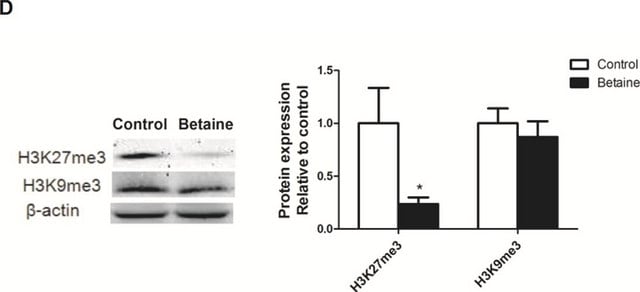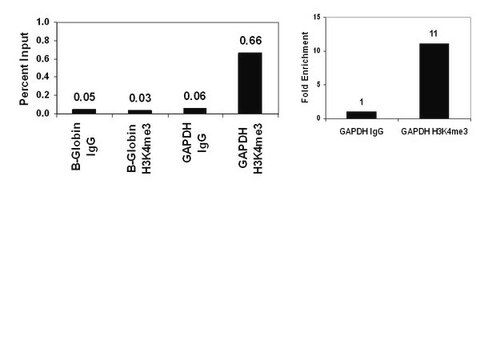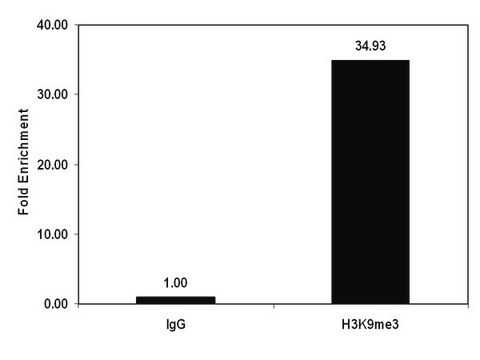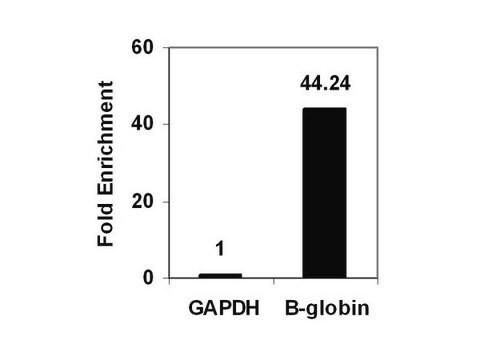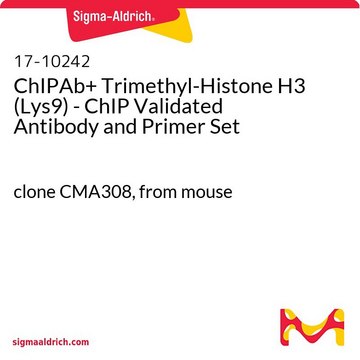17-643
ChIPAb+ Monomethyl-Histone H3 (Lys27) - ChIP Validated Antibody and Primer Set
serum, from rabbit
Synonym(s):
H3K27me1, Histone H3 (mono methyl K27)
About This Item
Recommended Products
biological source
rabbit
Quality Level
antibody form
serum
clone
polyclonal
species reactivity
human, mouse
species reactivity (predicted by homology)
mammals
manufacturer/tradename
ChIPAb+
Upstate®
technique(s)
ChIP: suitable
electrophoretic mobility shift assay: suitable
flow cytometry: suitable
immunofluorescence: suitable
immunohistochemistry (formalin-fixed, paraffin-embedded sections): suitable
immunoprecipitation (IP): suitable
western blot: suitable
NCBI accession no.
UniProt accession no.
shipped in
dry ice
Gene Information
human ... H3F3B(3021)
General description
The ChIPAb+ Monomethyl-Histone H3 (Lys27) set includes the anti-monomethyl-histone H3 (Lys27) antibody, a negative control antibody (normal rabbit serum), and qPCR primers which amplify a 110 base pair region within the promoter of the human β-globin gene. The monomethyl-histone H3 (Lys27) and negative control antibodies are supplied in a scalable "per ChIP" reaction size and can be used to functionally validate the precipitation of monomethyl-histone H3 (Lys27)-associated chromatin.
Specificity
Immunogen
Application
Successful immunoprecipitation of monomethyl-histone H3 (Lys27) associated DNA fragments was verified by qPCR using control ChIP Primers flanking the human GAPDH promoter or primers amplifying the promoter of human β-globin, which is transcriptionally inactive in HeLa cells (Please see figures). Percent Input relative to standard curves for each qPCR primer set are shown, with immunoprecipitated DNA from control serum shown as (-) and monomethyl- histone H3 (Lys27) as (+).
Please refer to the EZ-Magna A ChIP (Cat. #17-408) or EZ-ChIP (Cat. #17-371) protocol for experimental details.
Western blot analysis and peptide inhibition:
HeLa Acid extract was resolved by electrophoresis, transferred to nitrocellulose and probed with Anti-Monomethyl-Histone H3 (Lys27) (1:5000, Lane 1) or preincubated with 0.4 μM Histone H3 peptide with following modifications:
Lane 2: Linear non-modified
Lane 3: Branched monomethyl
Lane 4: Linear monomethyl
Lane 5: Branched dimethyl
Lane 6: Linear dimethyl
Lane 7: Branched trimethyl
Lane 8: Linear trimethyl
Proteins were visualized using a goat anti-rabbit secondary antibody conjugated to HRP and a chemiluminescence detection system (Please see figures).
Epigenetics & Nuclear Function
Chromatin Biology
Packaging
Quality
Sonicated chromatin prepared from untreated HeLa cells (1 X 106 cell equivalents) was subjected to chromatin immunoprecipitation using 4 μL of either a normal rabbit antiserum or Anti-Monomethyl-Histone H3 (Lys27) serum and the Magna ChIP A Kit (Cat. #17-610).
Successful immunoprecipitation of monomethyl-histone H3 (Lys27) associated DNA fragments was verified by qPCR using control ChIP Primers flanking the human β-globin promoter (Please see figures).
Please refer to the EZ-Magna A ChIP (Cat. #17-408) or EZ-ChIP (Cat. #17-371).
Target description
Physical form
Normal Rabbit Serum. One vial containing 100 uL antiserum containing 0.05% sodium azide.
ChIP Primers, β-Globin. One vial containing 75 μL of 5 μM of each primer specific for for human β-globin promoter.
FOR: AGG ACA GGT ACG GCT GTC ATC
REV: TTT ATG CCC AGC CCT GGC TC
Storage and Stability
Analysis Note
Included negative control antibody normal rabbit serum and control primers specific for human β-globin promoter.
Legal Information
Disclaimer
Storage Class Code
10 - Combustible liquids
Certificates of Analysis (COA)
Search for Certificates of Analysis (COA) by entering the products Lot/Batch Number. Lot and Batch Numbers can be found on a product’s label following the words ‘Lot’ or ‘Batch’.
Already Own This Product?
Find documentation for the products that you have recently purchased in the Document Library.
Our team of scientists has experience in all areas of research including Life Science, Material Science, Chemical Synthesis, Chromatography, Analytical and many others.
Contact Technical Service